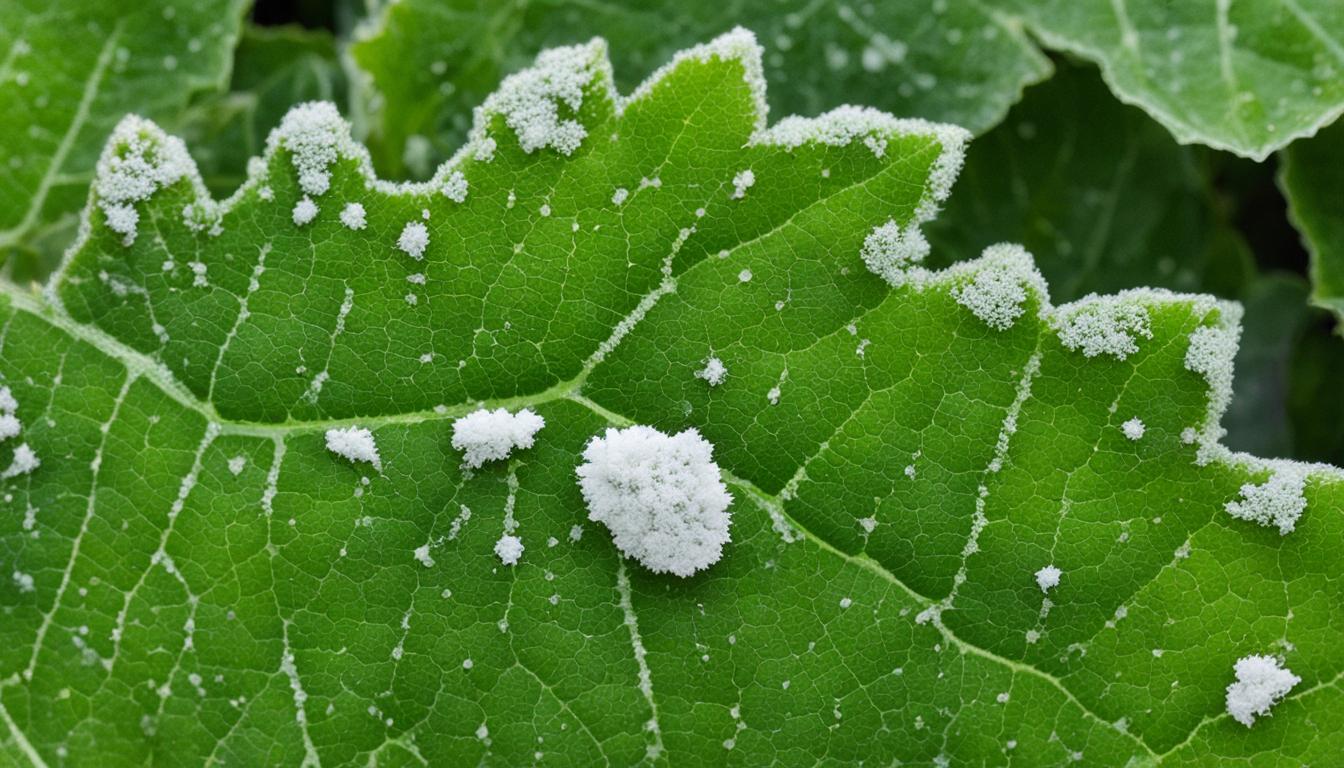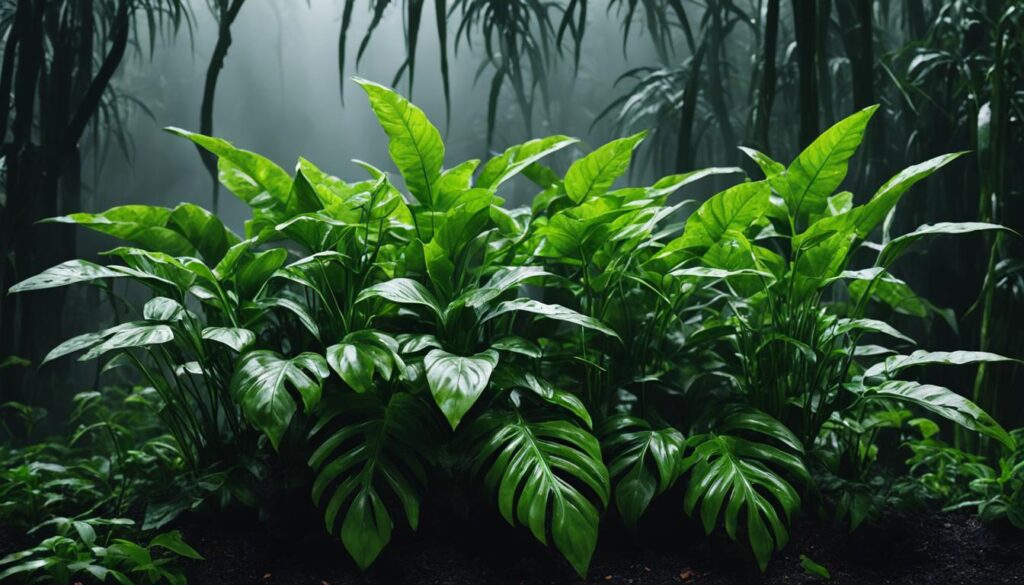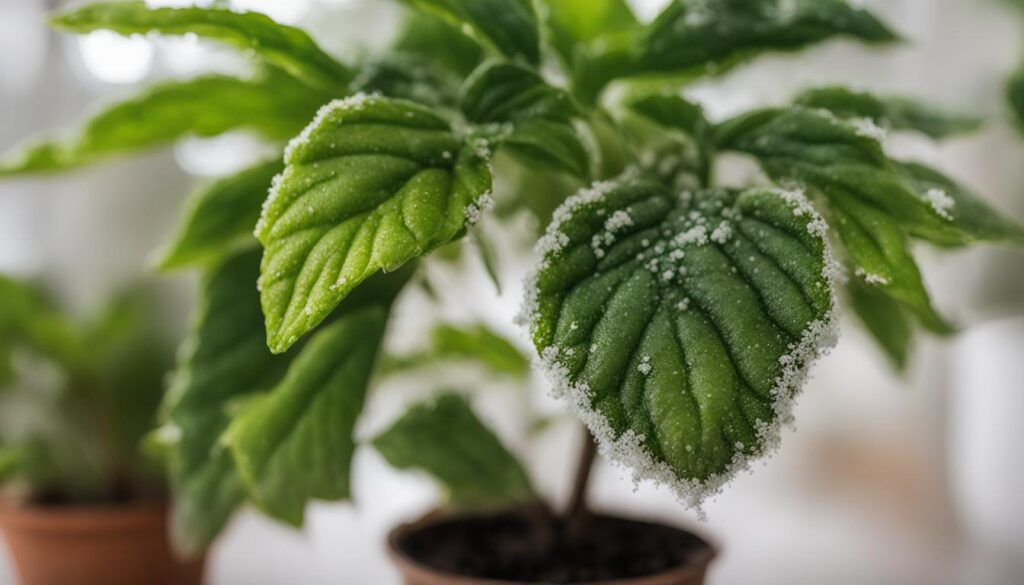
Combat Mold on Plants: Prevention & Care Tips
If you’re an avid gardener, you know that mold growth on plants can be a daunting issue to tackle. Not only does it affect the aesthetics of your garden, but it can also impact the health of your plants. Mold on plants is caused by a variety of factors, including excessive moisture and poor air circulation. It’s important to take proactive steps to prevent mold growth and ensure healthy, vibrant plants. In this section, we’ll share expert tips and insights on preventing and treating mold on plants.
Key Takeaways:
- Mold growth on plants can be caused by excessive moisture and poor air circulation.
- Preventative measures, such as proper watering and optimizing humidity levels, can significantly reduce the chances of mold growth.
- Timely action is crucial to treat mold on plants and restore their health.
- Selecting mold-resistant plants can help reduce the risk of mold growth.
- Creating a healthy environment for your plants is essential for mold management and prevention.
Understanding Mold on Plants
Plant mold is a type of fungus that can grow and spread rapidly if left unchecked. Mold on plants can weaken your greenery, making them more susceptible to other diseases and pests. Understanding the causes and signs of mold growth is crucial for effective prevention and management techniques.
The most common causes of mold on plants are high humidity levels, poor ventilation, and overwatering. These conditions create an ideal environment for mold spores to thrive and spread. Signs of mold growth on plants include a white or gray powdery substance on the leaves, stems, or flowers, and a musty or sour smell near the affected plant.
If you notice mold growth on your plants, it’s important to remove it immediately to prevent further spread.
While some molds pose no threat to your plant’s health, others can be highly destructive. Mold can cause leaf and fruit drop, stunted growth, and even death in severe cases. This is why it’s important to take a proactive approach to mold prevention and management.
The Importance of Mold Prevention on Plants
Preventing mold growth on plants is essential to ensure their health and vitality. Mold is a type of fungus that can thrive in warm, moist environments, such as potted plants, and can quickly damage the leaves, stems, and roots of your plants. Once mold growth begins, it can be challenging to control and can lead to irreversible damage to your plants.
Proper mold management on plants involves taking preventative measures to minimize the risk of mold growth. By doing so, you can create a healthy environment for your plants and promote optimal growth and development.
The Negative Impact of Mold on Plants
Mold growth on plants can be detrimental to their health. It can lead to yellowing of leaves, stunted growth, and even death. Additionally, mold on plants can attract harmful pests and insects, further compromising their health.
Not only does mold negatively impact plant health, but it can also affect the aesthetics of your garden. Mold growth on leaves can leave unsightly spots and blemishes, impacting the overall visual appeal of your plants.
Steps to Ensure Mold-Free Plants
Preventing mold growth on plants starts with proper plant care and maintenance. Here are some tips to ensure mold-free plants:
- Ensure plants are properly watered, and avoid overwatering
- Optimize humidity levels in your home or greenhouse
- Ensure proper air circulation around plants
- Clean and sterilize gardening tools regularly
- Choose mold-resistant plants
By taking preventative measures and keeping a watchful eye on your plants, you can minimize the risk of mold growth and keep your garden healthy and vibrant.
Tips for Preventing Mold on Plants
Mold growth on plants can be detrimental to their health and appearance. Here are some practical tips and techniques to prevent mold on your plants:
- Proper watering: Overwatering can increase humidity levels and create a favorable environment for mold to grow. Water your plants thoroughly, but make sure the soil is well-drained.
- Air circulation: Proper air circulation can prevent stagnant air and promote plant health. Consider using fans or opening windows to increase airflow.
- Optimizing humidity levels: Mold thrives in humid environments. Keep humidity levels low by using a dehumidifier or by placing a tray of pebbles with water beneath the plant’s pot.
- Mold-resistant plants: Choose plant varieties that are naturally mold-resistant, such as ferns, succulents, and cacti.
Implementing these preventative measures can significantly reduce the risk of mold growth on your plants and promote their overall health.
Take a look at the following table for some examples of mold-resistant plants:
| Plant Species | Light Requirements | Watering Needs |
|---|---|---|
| Sansevieria (Snake Plant) | Bright, indirect light | Sparse watering |
| Cactus | Bright, direct sunlight | Sparse watering |
| Succulents | Bright, indirect light | Infrequent watering |
| Spider Plant | Bright, indirect light | Regular watering |
| Bromeliads | Bright, indirect light | Minimal watering |

Takeaway:
Preventing mold on plants starts with proper care and maintenance. By implementing these tips, you can significantly reduce the risk of mold growth on your greenery. Choosing mold-resistant plants can also help in the prevention of mold infestation.
Identifying Mold on Plants
Mold on plants can be unsightly, but it can also be damaging to plant health and even lead to plant death. That’s why it’s essential to be able to identify mold growth on your plants. Here are some visual cues and common symptoms to look out for:
- Discoloration: Mold growth can result in yellow or brown spots on leaves or other parts of the plant.
- Texture: Mold-infected areas may have a fuzzy or slimy texture that stands out from the surrounding plant tissue.
- Odor: Some molds may produce a musty or unpleasant smell, which could be an indicator of mold growth on your plants.
- Growth pattern: Keep an eye out for any unusual growth patterns on your plants, like distortion or stunted growth, which could be the result of fungal or mold growth.
If you suspect mold growth on your plants, it’s important to act quickly. Isolate the affected plants to prevent further spread and consider treatment options to combat mold growth. Remember, early detection and intervention are crucial in managing mold on plants.
Treating Mold on Plants
If mold has appeared on your plants, it’s essential to take immediate action. Delaying treatment can result in the spread of mold to other plants, causing severe damage to your garden.
Here are some effective methods and treatments to eliminate mold and restore plant health:
- Prune affected areas: Start by pruning any affected areas of the plant with clean shears. Dispose of the pruned plant parts in a sealed plastic bag to prevent the spread of mold spores.
- Apply a fungicide: Applying a fungicide can help eradicate existing mold and prevent future growth. Choose a fungicide that’s safe for your plants and follow the instructions carefully.
- Adjust growing conditions: Mold thrives in warm and humid environments. Adjusting the growing conditions can help control mold growth. Ensure adequate ventilation, reduce humidity levels, and avoid overwatering your plants.
- Quaratine the plant: If mold has infected one of your plants, isolate it from your other plants to avoid spreading the mold spores.
By taking action as soon as you spot mold on your plants, you can effectively manage and eradicate mold growth, restoring your garden to its former glory.
Choosing Mold-Resistant Plants
Prevention is the best way to combat mold on plants, but selecting mold-resistant plants can also significantly reduce the chances of mold growth. When choosing plants for your garden, consider their natural resistance to mold and mildew. Some plants naturally produce antifungal compounds that provide a barrier against mold and other diseases.
When selecting plants, prioritize those that are known to be mold-resistant, such as:
- Marigolds
- Zinnias
- Geraniums
- Petunias
It’s also important to choose plants that are well-suited to your climate and growing conditions. Healthy plants are less susceptible to mold and other diseases.
Consider planting a diverse array of plants to discourage the spread of mold. A variety of colors and textures can also add visual interest to your garden.
Maintaining Healthy Plant Environment
Creating a healthy environment is crucial for preventing mold on plants. As mentioned in earlier sections, mold growth thrives in damp and humid conditions. Therefore, maintaining optimal moisture levels is essential for plant wellness.
Expert Tip: Be mindful of overwatering your plants as it can lead to standing water that fosters mold growth.
When watering your plants, ensure that excess water can drain out of the pot, and avoid watering during periods of high humidity or rainfall. Additionally, proper air circulation around plants can help prevent mold growth. You could use a fan nearby or place your plants in an area with good airflow.
If you notice any signs of mold on your plants, remove the affected parts immediately and use organic fungicides to prevent further mold growth. As an added measure, regular pruning and trimming of your plants can also promote healthy growth and minimize mold growth risks.
Common Mistakes to Avoid
When it comes to preventing mold on plants, avoiding common mistakes is essential. Here are some pitfalls to steer clear of:
Overwatering
One of the most common mistakes is overwatering plants, which can lead to excess moisture and the growth of mold. Be sure to water your plants only when necessary, and provide proper drainage to avoid water buildup.
Ignoring Signs of Mold
Ignoring signs of mold growth on plants can lead to the spread of the fungus and damage to your greenery. Inspect your plants regularly for any visual cues of mold, such as discoloration or a fuzzy texture, and take immediate action if you notice anything suspicious.
Poor Air Circulation
Inadequate air circulation around your plants can contribute to moisture buildup and the growth of mold. Ensure proper air flow by spacing out your plants and avoiding overcrowding.
Failure to Isolate Infected Plants
When you notice mold growth on a plant, it’s crucial to isolate it to prevent the fungus from spreading to other plants. Immediately remove any infected plants and dispose of them carefully.
Using Contaminated Tools
Using contaminated tools, such as shears or pruning scissors, can spread mold throughout your plants. Be sure to clean and disinfect your tools regularly to avoid cross-contamination.
By avoiding these common mistakes, you can ensure better plant health and minimize the risk of mold infestation.
Additional Tips for Mold Management on Plants
Preventing and managing mold growth on plants requires a multi-pronged approach. In this section, we will provide additional tips and insights to help you combat plant mold effectively. These strategies will enable you to maintain a mold-free environment and healthy greenery.
1. Optimize air circulation
Poor air circulation can contribute to mold growth on plants. Be sure to space out your plants to allow for proper airflow. You can also use fans or open windows to encourage circulation.
2. Use a proper watering technique
Overwatering can cause excess moisture, creating an ideal environment for mold to thrive. Water your plants thoroughly but avoid watering them too often.
3. Keep plant foliage dry
Wet leaves and stems can attract mold growth. Use a cloth or paper towel to dry off your plants if they get wet, especially during humid weather.
4. Use natural remedies
Natural remedies such as neem oil or cinnamon powder can be used to combat mold growth on plants. Mix these solutions with water and apply them to your plants to prevent further mold growth.

5. Monitor your plants regularly
Regular monitoring of your plants can help prevent mold growth from getting out of control. Make inspecting your plants a part of your daily routine, and take action at the first signs of mold growth.
By implementing these additional tips for mold management on plants, you can keep your greenery healthy and free of mold. Take a proactive approach to plant care, and you can enjoy a thriving garden full of vibrant, healthy plants.
Conclusion
By following the prevention and treatment tips provided in this article, you can effectively combat mold on plants and promote a thriving garden. Remember, the health of your plants is crucial for their overall well-being and vitality.
Implementing preventative measures such as optimizing humidity levels, proper watering, and selecting mold-resistant plants can significantly reduce the risk of mold growth. Additionally, taking immediate action to treat mold with effective methods and treatments can help restore the health of your plants.
Creating a healthy environment for your plants through proper care and maintenance is also essential to prevent mold growth. Be sure to avoid common mistakes that can contribute to mold infestation and regularly monitor your plants for signs of mold.
Ultimately, combating mold on plants requires a proactive approach and ongoing care. With these tips and insights for effective mold management, you can safeguard your plants and promote a mold-free environment in your garden.
FAQ
What causes mold to grow on plants?
Mold on plants can be caused by various factors, including excessive humidity, poor air circulation, overwatering, and plant stress. These conditions create a favorable environment for mold spores to thrive.
How can I prevent mold growth on my plants?
To prevent mold on plants, it’s important to maintain optimum humidity levels, provide proper air circulation, avoid overwatering, and regularly inspect your plants for signs of mold. Additionally, choosing mold-resistant plants can help minimize the risk of mold growth.
What are the common signs of mold on plants?
Common signs of mold on plants include fuzzy or powdery growth on leaves or stems, discoloration, wilting, and an unpleasant musty odor. If you notice these symptoms, it’s essential to take prompt action to prevent the spread of mold.
How can I treat mold on plants?
To treat mold on plants, you can gently wipe away the visible mold with a damp cloth or sponge. If the infestation is severe, you may need to trim affected leaves or stems. Properly dispose of any plant material to avoid further contamination. Applying fungicides or natural remedies may also help control mold growth, but it’s important to follow the instructions and guidelines provided by the manufacturer.
Which plants are resistant to mold?
Some plants naturally have a higher resistance to mold and fungus. Examples include Marigolds, Zinnias, Geraniums, Lavender, and Rosemary. Choosing these mold-resistant plants can help reduce the risk of mold growth in your garden.
How often should I water my plants to prevent mold?
Proper watering is crucial to prevent mold on plants. It’s best to water thoroughly but infrequently, allowing the topsoil to dry out slightly between waterings. Avoid overwatering, as it can create excessive moisture that promotes mold growth.
What are some common mistakes to avoid in preventing mold on plants?
Some common mistakes to avoid include overwatering, crowding plants together, neglecting proper air circulation, and not promptly removing dead or diseased plant material. These practices can contribute to moisture buildup and create an ideal environment for mold growth.
Are there any natural remedies to combat mold on plants?
Yes, there are several natural remedies that can help combat mold on plants. These include using a mixture of water and neem oil, spraying diluted apple cider vinegar, or applying a solution of baking soda and water. However, it’s important to test any natural remedy on a small area of the plant before applying it extensively.
How can I improve air circulation around my plants?
To improve air circulation, you can strategically space out your plants, prune overcrowded foliage, and use fans or other means of gentle air movement. This helps prevent stagnant air and reduces the risk of mold spore buildup.
Can mold on plants be harmful to humans?
While mold on plants is generally not harmful to humans, it can cause allergic reactions in individuals with sensitivities. It’s important to handle mold-infested plants with caution and practice good hygiene to minimize any potential health risks.




